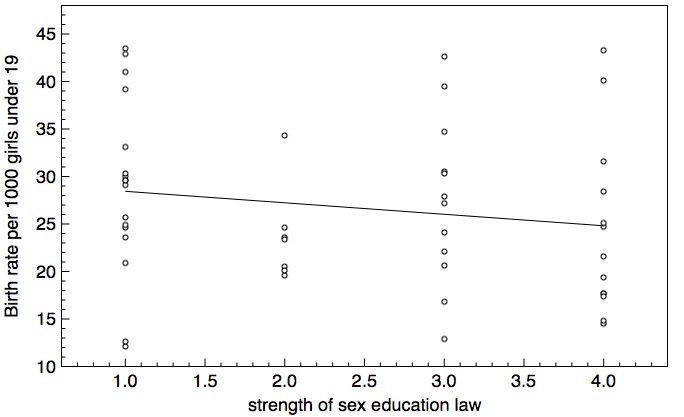The way sex education is taught in the United States is such a crazy-quilt of curricula that it’s hard to know what’s being taught to high school students, or how accurately. And when people lack that kind of data, they can easily make some pretty terrible mistakes.
Take, for example, Hannah Smothers’ article in Fusion a few weeks ago. She wants to talk about how the absence of any standards for sex education in the United States winds up hurting teenagers who go to schools that don’t provide sex ed. So she tries to correlate state laws on sex education to teen birth rates:
As you can see, states like Texas, Louisiana, Oklahoma, and Arkansas don’t require sex ed, and — surprise! — they have some of the highest teen birth rates in the country. Meanwhile, New Jersey and Vermont require both sex ed and contraception instruction, and they boast some of the lowest teen birth rates. There are outliers (see New Mexico), but experts say the association cannot be ignored.
Smothers doesn’t say which experts point to this particular association, but you can only reach it by cherry-picking states to match that conclusion.
That’s because the data she shows us actually has lots of “outliers.” Like California and Colorado, which require contraceptive instruction if sex ed is taught, but have middling-high teen pregnancy rates. Or West Virginia, New Mexico, North Carolina, and South Carolina, which require sex ed with contraceptive information but still have high teen pregnancy rates. Or Massachusetts, New Hampshire, and Pennsylvania, none of which mandate any sex education at all, but still manage to pull in low teen pregnancy and chlamydia rates.
I checked. Only 17 states out of 50 clearly support the thesis that state laws mandating sex education affect teen pregnancy. The others are all “outliers” of one type or another. That’s just not a strong association.
In fact, let me show you all exactly how weak the relationship between state law and teen pregnancy is in America. In this graph, I’ve coded the state laws based on the strength of their requirements: 1 for no state law requiring sex ed, 2 for states that make sex ed optional (although they require contraception instruction when it’s taught), 3 for states that require sex ed but not contraception instruction, and 4 for states that require both sex ed and contraception instruction. Teen births per 1000 girls data from 2013 comes from the National Campaign to Prevent Teen and Unplanned Pregnancy.
Smothers’ argument is that more stringent requirements should lead to lower teen pregnancy rates. But look at the actual results.

This analysis gives us a very slight correlation between stronger sex ed requirements and lower rates of teen pregnancy, but when I ran the statistics I found that the relationship isn’t statistically meaningful. (For those of you who want the crunch, the regression has an R-squared of 0.029. Statistically-speaking, it sucks.)
In fact, there are much bigger social factors affecting teen pregnancy than state laws that turn a couple of health class sessions over to a very embarrassed gym teacher or an outside speaker. Poverty is a huge one. Watch what happens when you correlate the teen birth rate for each state with its poverty rate. (The teen births data is again from 2013 and the National Campaign to Prevent Teen and Unplanned Pregnancy; the percentage of people living in poverty for each state comes from the US Census averages from 2010-2012.)

There are some weird outliers which might be the effect of states with low population density (like Alaska and Wyoming), but there’s a clear overall trend where higher rates of teen pregnancy occur in states where more people live in poverty. (And statistically speaking, the correlation is much stronger, with an R-squared of 0.64)
My point is that using state laws as a proxy for whether or not teenagers are getting reasonable and accurate information about sex, sexuality, healthy relationships, contraception, or STI prevention just doesn’t work. From the data we have, there’s no way of knowing whether teen pregnancy rates correlate at all to what they’re getting for sex ed. States with no official statutes requiring sex ed could still have internal educational policies that encourage schools to create comprehensive courses. So it’s entirely possible to have a terrible state-mandated sex education class, with a curriculum that’s incomplete or full of inaccuracies, as many state-mandated abstinence-only courses are. Or a school may provide a thorough and comprehensive course in a state that has no sex education laws at all.
There’s so much more for kids to learn than how to put on condoms. They need to know to form healthy relationships. The symptoms of common STIs. The correct names for all their parts, and how they’re supposed to work. The normal ways their bodies react to becoming sexually aroused. I could go on.
But if we really want to know the state of sex education in America we need to drill down to the level of individual schools in these states: when we don’t know what’s actually being taught, we have no way to examine whether it’s effective.
[Fusion]
Image by Africa Studio via Shutterstock
